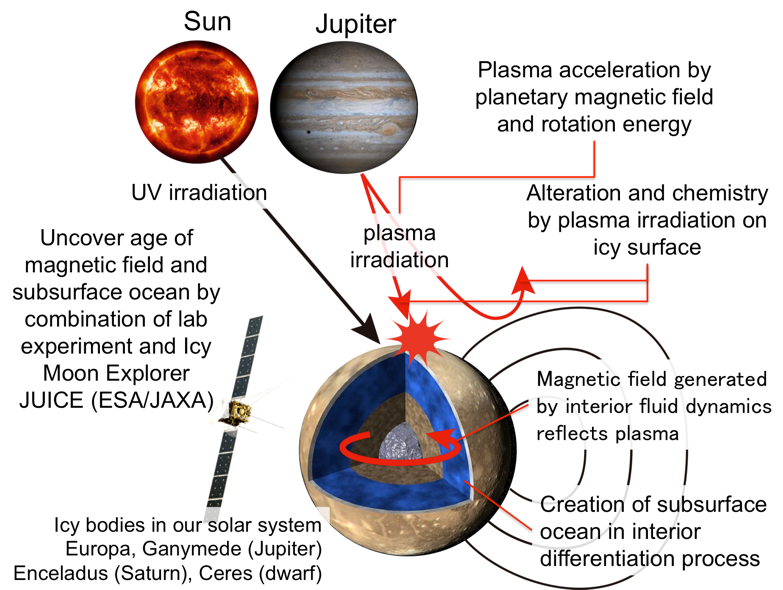| Program D01-1 | Synthesis and accumulation of space-weathered icy moon's surface materials uncovered by planetary quantum beam experiment and muon analysis |
|---|---|
| Principal Investigator | KIMURA, Tomoki (Tohoku University) |
Our final goal is to universally understand creation and evolution of
habitable environments in the space and atmosphere surrounding
planets.
Our current scope is the icy bodies in our solar system, at which
liquid water “subsurface ocean” is confirmed underneath
solid icy surface. The extra-terrestrial life like deep sea creatures
at Earth potentially exists in the subsurface ocean. In 2030s, we are
going to explore space and surface environments at Jupiter’s icy
moons “Ganymede” and “Europa” based on highly
precise “in-situ” measurement with spacecraft developed
in international collaboration with JAXA and ESA. Creation and
evolution of the subsurface ocean will be uncovered by our laboratory
experiment for the icy body's space environment in comparison with
the in-situ spacecraft observation.
The key for our goal is the space plasma surrounding the icy
body. The space plasma is accelerated by electromagnetic energy
deposited in intrinsic magnetic field and rotation of planet. The
energetic plasma irradiates materials of the icy body's
surface. Chemical and physical alterations on the surface materials

Figure: Grand design of this study. Jupiter's high energy plasmas,
which are energized by electromagnetic acceleration and
circulation in the magnetosphere, are irradiated to surfaces of
the icy moons Europa and Ganymede. The irradiated plasmas drive
synthesis and dissociation of icy surface materials, as known as
the space weathering. In this study, we try to quantify the
surface materials newly produced via the space weathering. The
quantified materials constrain age when the subsurface ocean
materials surfaced and duration of icy moon's intrinsic magnetic
field.
are driven by the irradiation, which is referred to as the
“space weathering”. The space weathering slowly
progresses on timescales up to 100s Mega years.
The icy body also has the intrinsic magnetic field that is generate
by fluid dynamics in the interior. The icy body magnetic field
reflects the space plasma, leading to dependence of the space
weathering on magnetic field strength on the surface. Based on
laboratory experiment for the space weathering in comparison with the
spacecraft exploration, we estimate the age of magnetic field that
constrains differentiation of the icy body interior including
development and evolution of the subsurface ocean.
In this study, we try to quantify the color agent that represents
degree of surface space weathering based on the muon beam analysis of
irradiated salty and icy samples, which constrain age when the
subsurface ocean materials surfaced and duration of icy moon’s
intrinsic magnetic field.
Members
- Principal Investigator
- KIMURA, Tomoki

(Frontier Research Institute for Interdisciplinary Sciences,
Tohoku University)
- Research Collaborators
-
NAKAUCHI, Yusuke (JAXA)
MURAKAMI, Go (JAXA)
KIMURA, Jun (Osaka University)
YOSHIOKA, Kazuo (The University of Tokyo)
Reference Materials
- T. Kimura et al., “Transient internally driven aurora at Jupiter discovered by Hisaki and the Hubble Space Telescope,” Geophys. Res. Lett. 42, 1662–1668 (2015), DOI:10.1002/2015GL063272
- T. Kimura et al., “Jupiter's X-ray and EUV auroras monitored by Chandra, XMM-Newton, and Hisaki satellite,” J. Geophys. Res. Space Physics 121, 2308–2320 (2016), DOI:10.1002/2015JA021893
- T. A. Nordheim, K. P. Hand, C. Paranicas, “Preservation of potential biosignatures in the shallow subsurface of Europa,” Nature Astronomy 2, 673–679 (2018)
- K. P. Hand, R. W. Carlson, “Europa's surface color suggests an ocean rich with sodium chloride,” Geophys. Res. Lett. 42, 3174–3178 (2015), DOI:10.1002/2015GL063559.
- K. K. Khurana, R. T. Pappalardo, N. Murphy, T. Denk, “The origin of Ganymede's polar caps,” Icarus 191, 193–202 (2007)
